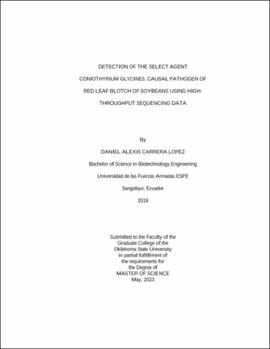| dc.contributor.advisor | Cardwell, Kitty F. | |
| dc.contributor.author | Carrera-Lopez, Daniel Alexis | |
| dc.date.accessioned | 2023-08-25T20:05:52Z | |
| dc.date.available | 2023-08-25T20:05:52Z | |
| dc.date.issued | 2023-05 | |
| dc.identifier.uri | https://hdl.handle.net/11244/338902 | |
| dc.description.abstract | The select agent Coniothyrium glycines, the causal pathogen of the disease red leaf blotch of soybeans, has not been identified in the U.S. Although C. glycines is listed as a select agent by the Federal Government, little information about its biology, evolution, and genomics is available, which poses a challenge to developing diagnostic tools. This research aimed to expand the general molecular and genomic knowledge of C. glycines and apply the generated information for detecting the pathogen using high-throughput sequencing (HTS) data. During this research, fourteen C. glycines isolates obtained from Zambia and Zimbabwe were used. A multilocus phylogenetic analysis was performed using two non-coding and two coding genes, revealing that isolates from matching locations form monophyletic clades. The results also suggested the movement of the fungus across borders since some isolates from different countries had the same common ancestor. Based on the topology of the phylogenetic tree, five representative isolates were selected, and their whole genome was assembled using Oxford Nanopore Technologies and Illumina sequencing data. Finally, the generated assemblies and the MiFi® web application were used to develop and validate three e-probe sets for the detection and differentiation of C. glycines isolates. The limit of detection (LOD), sensitivity, and specificity was estimated using in silico, in vitro, and in vivo approaches. LOD was influenced by the number of e-probes, sequencing read length, and sequencing platform. Once the LOD was exceeded, the sensitivity and specificity were 100%, allowing a reliable detection and discrimination of C. glycines isolates. The obtained results contribute to the molecular and genomic knowledge of C. glycines, facilitating future research on this organism. Additionally, these findings provide valuable guidelines for using HTS-based e-probe detection and discrimination of C. glycines to improve current biosecurity measures. | |
| dc.format | application/pdf | |
| dc.language | en_US | |
| dc.rights | Copyright is held by the author who has granted the Oklahoma State University Library the non-exclusive right to share this material in its institutional repository. Contact Digital Library Services at lib-dls@okstate.edu or 405-744-9161 for the permission policy on the use, reproduction or distribution of this material. | |
| dc.title | Detection of the select agent Coniothyrium glycines, causal pathogen of red leaf blotch of soybeans using high-throughput sequencing data | |
| dc.contributor.committeeMember | Espindola, Andres | |
| dc.contributor.committeeMember | Marek, Stephen | |
| dc.contributor.committeeMember | Ochoa-Corona, Francisco | |
| osu.filename | CarreraLopez_okstate_0664M_18029.pdf | |
| osu.accesstype | Open Access | |
| dc.type.genre | Thesis | |
| dc.type.material | Text | |
| dc.subject.keywords | coniothyrium glycines | |
| dc.subject.keywords | detection | |
| dc.subject.keywords | e-probes | |
| dc.subject.keywords | Edna | |
| dc.subject.keywords | microbe finder - mifi | |
| dc.subject.keywords | soybean | |
| thesis.degree.discipline | Entomology and Plant Pathology | |
| thesis.degree.grantor | Oklahoma State University | |
